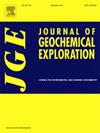欧洲农业土壤中铬空间分布的新大陆尺度模式——系统方法验证
IF 3.3
2区 地球科学
Q1 GEOCHEMISTRY & GEOPHYSICS
引用次数: 0
摘要
在以镍为重点的实验调查之后,很明显,地球化学数据集的数字图像分析的关键进展需要对使用另一元素的程序进行验证。之所以选择铬,是因为它的地球化学行为在岩性背景和表面过程中与镍的地球化学行为密切相关。我们目前的研究以严格的方法精度进行,旨在评估一种新的地理空间技术,能够捕捉空间可变的大陆尺度元素分布模式。为了减少局部异常,我们对基于tin的插值Cr数据集应用了移动平均滤波器。然后对处理后的网格进行数字图像分析,突出显示了几个大陆尺度的空间方向——NE-SW, E-W和NW-SE——与Ni研究中发现的非常相似。值得注意的是,发现了明显的NE-SW和ENE-WSW线性Cr构造,与已知的Variscan和Alpine造山带的构造印记一致。铬可变浓度升高主要发生在巴尔干和阿尔卑斯地区,与基性-超基性岩性暴露相一致。在末次大冰期终末带,还观察到明显的东西走向的Cr特征,向北浓度较低,与贫Cr冰川河流沉积相一致。在芬诺斯坎迪亚、希腊共和国、意大利北部和比利牛斯山脉等地区,铬的异常也呈西北-东南趋势,与镍的异常一致。除了证实图像分析技术在揭示和描述新的地球化学空间模式方面的有效性之外,本研究还通过显示Cr和Ni分布之间明显的大陆尺度空间对应关系来强化该方法。本文章由计算机程序翻译,如有差异,请以英文原文为准。
GEMAS: Novel continental-scale patterns revealed in the spatial distribution of Cr in European agricultural soil – A systematic method validation
Following the Ni-focused experimental investigation, it was clear that a critical advancement in digital image analysis of geochemical data sets required the validation of the procedures used with another element. Chromium was selected because its geochemical behaviour closely mirrors that of Ni in both lithological context and surface processes. Our current study, conducted with rigorous methodological precision, aims to assess a novel geospatial technique capable of capturing spatially variable continental-scale element distribution patterns. To reduce localised anomalies, we applied a moving average filter to the TIN-based interpolated Cr data set. The processed grid was then subjected to digital image analysis, which highlighted several continental-scale spatial orientations — NE-SW, E-W, and NW-SE — that closely resemble those found in the Ni study. Notably, prominent NE-SW and ENE-WSW linear Cr structures were identified, aligning with the known structural imprints of the Variscan and Alpine orogenic belts. Elevated Cr variable concentrations mainly occur in the Balkans and Alpine regions, consistent with exposures of mafic to ultramafic lithologies. A striking east-west trending Cr feature, with lower concentrations northwards, was also observed within the terminal zone of the last major glaciation, aligning with Cr-depleted glaciofluvial deposits. Chromium anomalies with a NW-SE trend also occur in regions such as Fennoscandia, Hellenic Republic, northern Italy, and the Pyrenees, aligning with those for Ni. Beyond confirming the efficacy of image analysis techniques in uncovering and describing new geochemical spatial patterns, this research also reinforces the approach by showing a pronounced continental-scale spatial correspondence between Cr and Ni distributions.
求助全文
通过发布文献求助,成功后即可免费获取论文全文。
去求助
来源期刊

Journal of Geochemical Exploration
地学-地球化学与地球物理
CiteScore
7.40
自引率
7.70%
发文量
148
审稿时长
8.1 months
期刊介绍:
Journal of Geochemical Exploration is mostly dedicated to publication of original studies in exploration and environmental geochemistry and related topics.
Contributions considered of prevalent interest for the journal include researches based on the application of innovative methods to:
define the genesis and the evolution of mineral deposits including transfer of elements in large-scale mineralized areas.
analyze complex systems at the boundaries between bio-geochemistry, metal transport and mineral accumulation.
evaluate effects of historical mining activities on the surface environment.
trace pollutant sources and define their fate and transport models in the near-surface and surface environments involving solid, fluid and aerial matrices.
assess and quantify natural and technogenic radioactivity in the environment.
determine geochemical anomalies and set baseline reference values using compositional data analysis, multivariate statistics and geo-spatial analysis.
assess the impacts of anthropogenic contamination on ecosystems and human health at local and regional scale to prioritize and classify risks through deterministic and stochastic approaches.
Papers dedicated to the presentation of newly developed methods in analytical geochemistry to be applied in the field or in laboratory are also within the topics of interest for the journal.
 求助内容:
求助内容: 应助结果提醒方式:
应助结果提醒方式:


